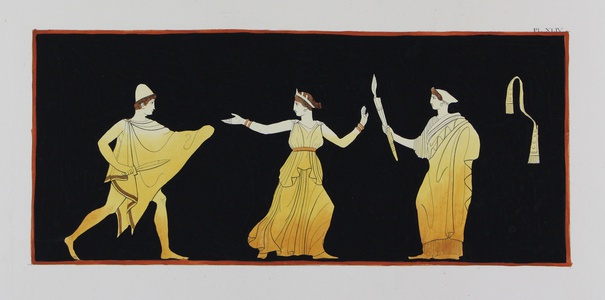| Method | Copper engraving with hand colouring |
| Artist | Antoine Clener |
| Published | A Paris de l'Imprimerie de P. Didot l'Aine MDCCCVIII [1808] |
| Dimensions | Image 128 x 290 mm, Plate 165 x 310 mm, Sheet 433 x 581 mm |
| Notes |
A depiction of a red-figure vase decoration of a young hero with a pair of women, Plate 44 from Volume 1 of Peintures de vases antiques, vulgairement appelés étrusques. The youth, wearing a loose-fitting cloak and conical cap, and carrying an unsheathed short-sword, strides forward towards a young woman, who gestures for him to follow. Her hair is tied up in a diadem, and she wears a sleeveless peplos and bracelets around her arms. To the right, a second woman with hair bound up in a headscarf and wearing a long cloak, is most likely a maidservant or attendant. She holds a lit torch, suggesting a clandestine and nocturnal scene. The identity of the central figures of the scene are unknown. Millin suggests that the most popular subject in scenes such as this involve Clytemnestra. Clytemnestra, the sister of Helen, was the wife of Agamemnon, leader of the Greeks in the Trojan War. Scenes of the tragic myth cycle involving Agamemnon and Clytemnestra were well known and well represented in Greek vase painting. If this is the case here, the central woman may by Clytemnestra herself, goading her lover Aegisthus to murder her husband. Alternatively, the scene may represent part of the aftermath of these actions. The armed youth may be Orestes, son of Agamemnon, with the central female figure representing his sister Electra. Clytemnestra, their mother, is the unseen target of the violence to follow. Despite noting the popularity of this sort of identification, Millin actually prefers a third option, centring around the luckless hero Amphiaraus, goaded into beginning the conflict of the Seven Against Thebes by his wife Eriphyle. Amphiaraus, having the gift of foresight, knew the venture was destined to fail, and aware of his wife's treachery, made his son Alcmaeon take an oath to avenge him. Peintures de vases antiques, vulgairement appelés étrusques was an early nineteenth century French answer to the hugely popular and influential series of engravings and descriptions of Greek vases assembled by Sir William Hamilton, the British envoy to the Kingdom of Naples and Sicily. Following the withdrawal of the British from Bourbon Naples, in the face of Napoleon and the revolutionary army, the excavations of archaeological sites in the region yielded numerous examples of Greek red-figure vases for French museums, galleries, and private collectors. Authored by Aubin-Louis Millin de Grandmaison, the leading French authority on Greek vases, and featuring illustrations by Antoine Clener, the two-volume publication featured examples of Greek vase painting from the Malmaison, the Musee Napoleon, the Bibliotheques imperial and nationale, and numerous private French collections. In style, it closely resembled the two different editions illustrating Hamilton's vases. The artist Clener had even been the pupil of Hamilton's artist Tischbein during the preparation of plates for his second publication. Akin to this second Hamilton collection, the plates in the Peintures de vases antiques were left uncoloured at publication, ostensibly for the benefit of artists and academics wishing to study the fine details of line and composition, though the publication contained a similar note to connoisseurs that with the assistance of a skilled colourist, the full impact of these masterworks of classical art could be appreciated by the discerning collector. Antoine Clener (fl.1790-1810) was a French engraver, principally known for his plates of Greek vases. As a young man, he worked as a pupil of Johann Heinrich Wilhelm Tischbein, and it was likely through his master's work on the Hamilton vases that gained him his most notable commission producing copper engraved plates for Millin de Grandmaison's Peintures de vases antiques, vulgairement appelés étrusques. Aubin-Louis Millin de Grandmaison (19th July 1759 – 14th August 1818) was a French author, antiquarian, connoisseur, and natural historian. Having fallen foul of the Jacobins and removed from his editorship of the Chronique de Paris, he was later appointed the chair of archaeology at the Bibliotheque nationale, expanding the institute's holdings of classical and medieval art, and becoming, in the last decades of his life, a specialist on the subject of classical vase painting. In addition to his antiquarian work, he was also a prominent member of the naturalist community, founding the world's first Linnean Society. Condition: Minor time-toning to edges of sheet. Otherwise a strong impression in superb heavy colour. |
| Framing | unmounted |
| Price | £275.00 |
| Stock ID | 43505 |

